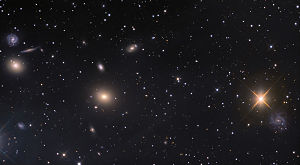NGC 1057
| Galaxy NGC 1057 |
|
|---|---|

|
|
| Panoramic image with a 60-cm telescope of the galaxy NGC 1057, NGC 1060 , NGC 1061 , NGC 1066 and NGC 1067 (right to left, NGC 1057 is located slightly above the center) and other galaxies that are not in the New General Catalog lists are. | |
| AladinLite | |
| Constellation | triangle |
|
Position equinox : J2000.0 , epoch : J2000.0 |
|
| Right ascension | 02 h 43 m 02.9 s |
| declination | + 32 ° 29 ′ 28 ″ |
| Appearance | |
| Morphological type | S0 |
| Brightness (visual) | 14.9 mag |
| Brightness (B-band) | 15.9 mag |
| Angular expansion | 1.2 '× 0.8' |
| Position angle | 115 ° |
| Surface brightness | 14.7 mag / arcmin² |
| Physical data | |
| Redshift | 0.019300 |
| Radial velocity | 5786 km / s |
|
Stroke distance v rad / H 0 |
(263 ± 18) · 10 6 ly (80.6 ± 5.6) Mpc |
| history | |
| discovery | George Johnstone Stoney |
| Discovery date | December 1849 |
| Catalog names | |
| NGC 1057 • UGC 2184 • PGC 10287 • CGCG 505-037 • MCG + 05-07-033 • 2MASX J02430289 + 3229283 • GC 595/596 • LDCE 176 NED027 | |
NGC 1057 is a lenticular galaxy of the Hubble-type S0 in the constellation Triangle in the northern sky . It is estimated to be 263 million light years from the Milky Way and about 90,000 light years in diameter.
The object was discovered in December 1849 by George Johnstone Stoney using William Parsons ' Leviathan telescope.
Web links
Commons : NGC 1057 - collection of images, videos, and audio files
